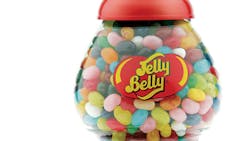Jelly beans are tricky business.
They look simple enough -- little pills of confectionary goodness, a handful of colors, a handful of flavors, consumable by the handful. Nothing could be easier.
But at Jelly Belly -- the gourmet jelly bean pioneer from Fairfield, Calif. -- these tiny treats represent one of the most complicated global process manufacturing feats in the industry.
"Making jelly beans is an extremely, extremely complicated manufacturing process," explains Dan Rosman, vice president of IT at Jelly Belly.
There are, he says, 50 official flavors of Jelly Belly jelly beans, with another 130 unofficial flavors in the mix. Each of those 180 flavors, from "buttered popcorn" to "stinky socks," require seven to 14 days of cooking, cooling, molding, drying and shell-building to complete -- a process it has taken the company 144 years to perfect.
And that's just the beginning.
After production, each bean is stamped with its own tiny Jelly Belly logo and sent on to a multistage packaging process that sorts the beans by flavors or colors or themes and then bags or boxes them by the dozen or by the hundreds or even individually for the real candy connoisseurs. Then they are shipped to a complex matrix of global shops, wholesalers and candy boutiques, each with their own strict demands on ingredients, delivery schedules and preferences.
See Also: Manufacturing Industry Technology News & Trends
With an endless supply of sophisticated, end-to-end 21st century enterprise resource planning (ERP) software suites at our disposal, even complex systems like this should be simple work. Only, until just a few years ago, Jelly Belly had been navigating its convoluted system with nothing but a 20-year-old green-screen ERP system to keep it together.
"Our ERP system was horrible," Rosman says. "It didn't have any capacity-planning capabilities; it had no costing capabilities; it had no demand planning or forecasting functionality. It couldn't do anything for our manufacturing."
Which means that in this high-tech, automated age, Jelly Belly was getting by with essentially the same system Gustav Goelitz used when he founded the company in the age of the horse and buggy: spreadsheets and hunches.
"We didn't even have a distribution order system, so we had people just trying to figure out where the containers needed to go and when they needed to get there," Rosman recalls. "We had two people who did nothing but jockey spreadsheets to try to figure out what the cost of the products were. And I can tell you, they were horribly, horribly, horribly inaccurate."
As it stood, as late as 2005, Jelly Belly had no way to determine which products were profitable, where the products were selling, or even how much any individual flavor cost to manufacture. Worse, the company had no way to know the extent of its ignorance.
That is, until it began looking into building a new plant in Thailand in the early 2000s.
"We suddenly found out there was no way that the old ERP system would allow us to manage multiple facilities," Rosman says. "There was just no way to do it. So we finally had to upgrade."
And with that, Jelly Belly began one of the most difficult, expensive and complicated procedures manufacturers can endure: a total, head-to-toe 21st-century ERP implementation.
A Bumpy Ride
"An ERP implementation is never simple," says Rick Veague, chief technology officer at ERP provider IFS North America.
After all, he says, a new implementation process like the one Jelly Belly was in store for basically requires ripping out and redesigning every aspect of the business, from order entry through manufacturing all the way to delivery.
"That is always going to be a little bumpy," he says.
Bumpy and expensive.
According to Epicor's 2013 ERP Report, implementation costs over the last four years average about $7.3 million and take nearly a year and a half to complete.
Implementing a system at a company like Jelly Belly -- with legacy processes running back to the 19th century and a system maintained by the tribal knowledge of its most experienced workers -- could easily exceed those averages by a wide margin.
However, as Veague says, "ERP implementations don't have to be painful. But you have to start off with a clear plan."
With a careful strategy in place, he says, even a Jelly Belly implementation can work on budget and on time.
And such plans always start in the same place: selecting the right vendor.
The Selection Plan
"The most important element of a successful implementation is selecting the right system for the company," explains Josh Cole, principal manufacturing and distribution performance service leader for CPA consulting firm Crowe Horwath. "It's your selection methodology that is going to determine if your implementation model leads to success or to failure."
This is the first real challenge in the process. Over the last decade, there has been an explosion of ERP technologies and tools. Between game-changing innovations like the cloud and mobility and the development of ever more sophisticated and customizable systems, manufacturers shopping for ERP systems find themselves facing hundreds of options with thousands of features that, with the exception of price, seem indistinguishable at first glance.
"If you look at 'functional fit' alone for system selection" -- big picture criteria like part tracking and purchase order processing -- "you're going to get 90% to 100% acceptance on every system you look at," Cole says. "Where the real differentiation is, is what we call the strategic investment criteria."
Those criteria, he says, break down into four key steps that manufacturers should follow to find their vendor:
Step One: Narrow the Verticals
"More and more providers are realizing that they can't just be that generic manufacturing ERP provider -- they have to go deep in specific verticals, or even micro-verticals," Cole says. And that's exactly where Jelly Belly began.
"There were a ton of ERP systems and vendors for us when we first started looking," Rosman explains. "But, first and foremost, we are a process manufacturer and we needed a system that could handle all of the variables that presents."
In the Jelly Belly system, he explains, issues like shrinkage, evaporation and size fluctuations, along with "belly flops" -- misshapen, oddball byproducts that are sold as specialty products -- can severely change the profitability equations.
"For us, we knew the software had to account for all of those variables," Rosman says. "We knew we needed a product that would help us track that and control it. That's something we never had before."
Running the crowded field of options through that simple filter, he says, narrowed the market down considerably.
So far so good.
Step Two: Pilot Tests
"You cannot test enough in today's environment," Chase says. "With the complexities of functions and technologies behind the curtains of these systems, not fully testing them in a 'day-in-the-life' replication of a go-live would be a fatal error."
At Jelly Belly, this step meant a two-round conference-room pilot competition between contenders, winner take all.
For the first round, each competing vendor was given a flowchart of Jelly Belly's manufacturing process and access to all the information they needed to build a complex bill of materials for a ten-flavor shower gift box -- one of the more complicated and taxing orders the company serves.
That challenge alone cut the group down by about half.
After that, Rosman says, the remaining companies were invited back for the real test.
"We brought them back and said, 'Now show us how you run the rest of the business around that manufacturing process,'" he recalls. "For a process manufacturer that's key. And then we had them tie it into order entry and accounting and purchase order processing and all that stuff that goes around that manufacturing exercise."
That round -- basically translating what Jelly Belly had been doing on disparate spreadsheets for a century and a half into a concise, integrated network -- took out all but a handful of contenders. Even, surprisingly, the "big, big, big names," as Rosman notes.
From there, it was up to the users to decide.
Step Three: User Tests
Jelly Belly CEO Herman Rowland is a fourth-generation candy man -- an old-school industrialist with a rich heritage in the candy business. That has made him a little averse to high-tech solutions like this ERP implementation.
Given the choice between a multimillion-dollar investment in software to improve productivity and an equal investment in manufacturing equipment to increase productivity, Rowland always leans to the latter. "That's just the way he is," Rosman says.
But when the need for this system overtook that productivity predilection, he made it clear that usability would be the driving factor for whatever decision they made. ERP may not be the tool he wanted in his plants, but he made sure when it got there that it was something his workers could actually use.
And that was exactly the right place to start.
"The most important element of any system is the usability of the application," IFS' Veague explains. "Because, let's face it, if an application is too complex to use, people won't use it. Or worse, they'll get a very basic implementation going and they won't take advantage of the full capabilities of whatever solution they use."
The days of going into the office and sitting down at a green screen terminal to get information are gone, he says. "When I talk about user experience, it's not key clicks. It's 'Can I get the information I want and can I get it fast and can I get it when I need it.' That's what I tell customers to look for -- if they can use the system as they need it to be used."
Jelly Belly's users, eager for tools to help them jump into the new century, took their time testing the software, inputting data, transferring their old methods to each new media. And in short order, they had cut the list down to two vendors, with a strong leaning to one in particular.
Step Four: Check Under the Hood
"When we went into this decision process, we knew it was not going to be a technology choice," Rosman explains. "It was going to be a business choice -- which application will help us do manufacturing the best and run the rest of the business."
But in the end, he said, it all came down to technology anyway.
"A solid technology architecture is very key investment criteria," Cole says. "Technology is absolutely a feeder to the flexibility of the system, the scales you need to support it to create reports or draw information out of it. It feeds into viability."
At Jelly Belly, facing just two competitors, Rosman began looking down the road at what it would take to actually implement the leading solution -- how many servers it would require, what kind of servers, what operating systems, what language it was coded in, etc. All those "technology pieces and parts," as he calls them.
What he found was surprising.
"The number one choice from the user community had the most horrific underlying infrastructure you could imagine," he says. "It was a really scary picture."
Despite the sleek front-end interface that won over the users, on the back end was a mix of four different operating systems, five different middleware technologies and a weird mishmash of program languages tying them all together -- an impossible nightmare that would fall on Rosman and his team to maintain.
The second-place choice, though not as strong on the user-interface side, was internally consistent and internally strong -- "a very, very integrated system," he says.
And that was that.
"After all of our user-first focus, at the very end of the decision process, we did make a technology decision," he says. "But the users were OK with that. It was a no-brainer to go in for a simpler and smaller technology footprint. We don't feel like we sacrificed anything at all on the front end."
After a full year of intensive investigations, studies, competitions and tests, Jelly Belly chose Infor -- an ERP provider with the process manufacturing focus and the deep micro-vertical functionality that the company was looking for.
And then the real work began...
Stay tuned for part two of this series, "Building the Jelly Belly System."
About the Author
Travis M. Hessman
Editor-in-Chief
Travis Hessman is the editor-in-chief and senior content director for IndustryWeek and New Equipment Digest. He began his career as an intern at IndustryWeek in 2001 and later served as IW's technology and innovation editor. Today, he combines his experience as an educator, a writer, and a journalist to help address some of the most significant challenges in the manufacturing industry, with a particular focus on leadership, training, and the technologies of smart manufacturing.


